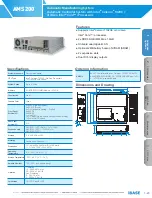
The flue or chimney must be made of fire resistant
material, preferably ceramics or stainless steel.
The flue or chimney must be airtight and well
cleaned and guarantee sufficient draught.
A draught/vaccuum of 15 - 20 Pa during normal
operation is ideal.
Starting from the flue spigot, the flue must run as
vertically as possible. Changes in direction and
horizontal pieces disrupt the outward flow of
combustion gases and may cause the deposit of
soot.
The interior measurements should not be too big, to
prevent the combustion gases from cooling down
too much, thereby reducing the draught.
The flue or chimney must ideally have the same
diameter as the connection collar.
For the nominal diameter: see the appendix
"Technical data". If the smoke channel is well
insulated, the diameter may be slightly bigger
(up to 2x the section of the connection collar).
The section (area ) of the smoke channel must be
constant. Wider segments and (in particular)
narrower segments disrupt the outward flow of
combustion gases.
When using a cover plate or exhaust hood: make
sure that the cover does not restrict the flue outlet
and that the cap does not impede the outward flow
of combustion gases.
The chimney must end in a zone that is not
affected by surrounding buildings, adjacent trees or
other obstacles.
The chimney part outside the house must be
insulated.
The chimney must be at least 4 metres high.
As a rule of thumb: 60 cm above the ridge of the
roof.
If the ridge of the roof is more than 3 metres away
from the flue: stick to the measurements in the
following figure. A = the highest point of the roof
within a distance of 3 metres.
Ventilation of the area
For good combustion, the appliance needs air
(oxygen). That air is supplied via adjustable air inlets
from the area where the appliance is installed.
The combustion will be incomplete in case of
insufficient ventilation, which results in toxic
gases being produced and spread through the
area.
As a rule of thumb, the air supply should be
5.5 cm²/kW. Extra ventilation is needed when:
The appliance is in an area that is well insulated.
There is mechanical ventilation, for example a
central extraction system or an extraction hood in
an open kitchen.
You can provide extra ventilation by having a
ventilation louvre installed in the outside wall.
Make sure that other air consuming appliances (such
as tumble-driers, other heating appliances or a bath
room fan) have their own supply of outside air, or are
switched off when you use the appliance.
You can also connect the appliance to a supply
of outside air. For this purpose, a connecting
kit has been included. Extra ventilation is not
needed in that case.
Subject to change because of technical improvements
5
Содержание 2576CBSC
Страница 21: ...Wijzigingen op grond van technische verbeteringen voorbehouden 21 Bijlage 2 Afmetingen 2576CBSC 09 20017 000 ...
Страница 27: ......
Страница 47: ...Appendix 2 Measurements 2576CBSC 09 20017 000 Subject to change because of technical improvements 21 ...
Страница 53: ......
Страница 74: ...Annexe 2 Dimensions 2576CBSC 09 20017 000 22 Sous réserve de modifications dues à des améliorations techniques ...
Страница 100: ...Anlage 2 Abmessungen 2576CBSC 09 20017 000 22 Änderungen aufgrund technischer Verbesserungen vorbehalten ...
Страница 125: ...Anexo 2 Medidas 2576CBSC 09 20017 000 Dovre se reserva el derecho de realizar cambios por razones técnicas 21 ...
Страница 131: ......
Страница 151: ...Allegato 2 Dimensioni 2576CBSC 09 20017 000 Con riserva di modifiche per miglioramenti tecnici 21 ...
















































